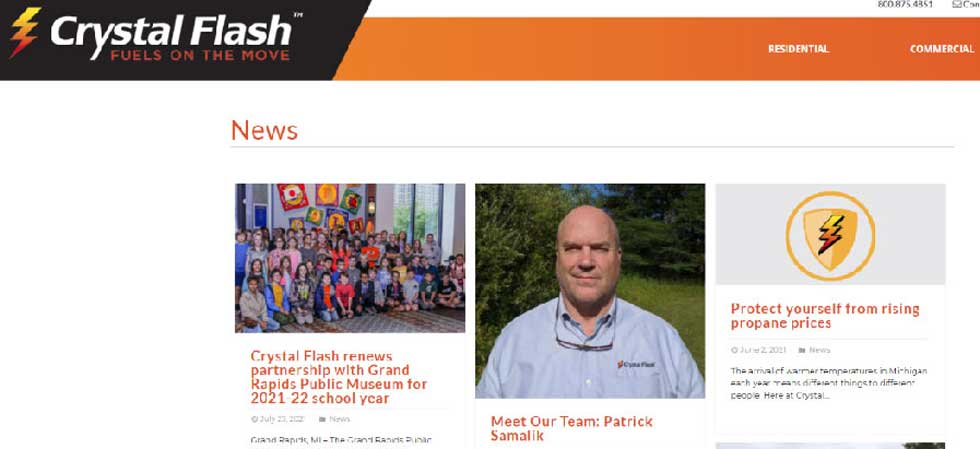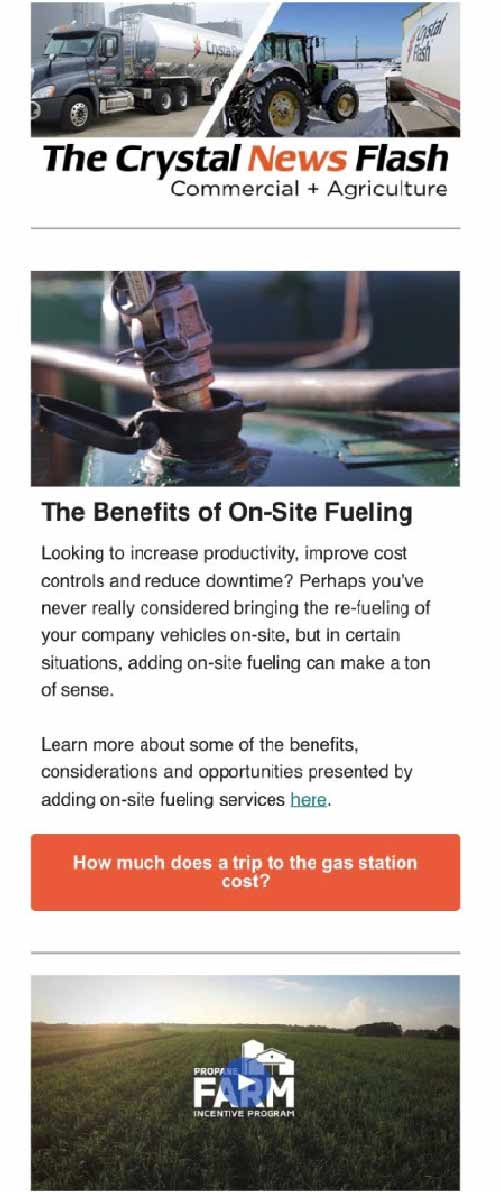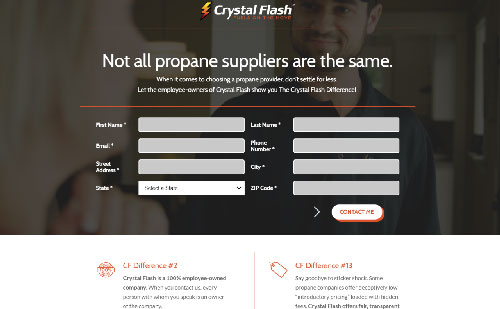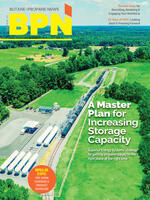
Crystal Flash wanted to communicate to its customers the things that set it apart from its competitors. The Grand Rapids, Michigan-based energy distribution company decided a good way to do that is with content marketing. By creating e-newsletters that provide customers with news and educational content, the company can also showcase the numerous qualities that add up to “The Crystal Flash Difference.”
“Offering what many people would consider to be commodities, Crystal Flash places a strategic emphasis on differentiation,” said Scott Miller, marketing manager at the seller and distributor of propane, diesel, gasoline and lubricants. The company developed The Crystal Flash Difference campaign in late 2019. This includes 30 facts that showcase what makes the company different from the competition. “These ‘differences’ generally fit into five categories: our people, our attention to safety, our customer care, our values and culture and the fact that we offer freedom of choice,” Miller explained.
To help disseminate this information, the company launched its two e-newsletters in early 2020. One is for residential customers while the other is for commercial and agricultural customers. The e-newsletters are published on alternate months. At the same time, staff created several different “buckets” on the company’s website in which to put the content that wouldn’t fit in the e-newsletters.
For non-time-sensitive/evergreen content, there’s a “Support Directory.” The directory currently includes 30 different reference articles. More timely pieces of content head to the “News” section of the website. Customers see the first paragraph of each article in an e-newsletter and then click through to see the complete article on the company’s website. Other readers discover the articles through search engines or when visiting the Crystal Flash site.
 Almost all that content is distributed through the company’s social media feeds, too. A year and a half after launching these resources, customers are responding to the new content in ways the company hoped they would. Miller shared the following metrics:
Almost all that content is distributed through the company’s social media feeds, too. A year and a half after launching these resources, customers are responding to the new content in ways the company hoped they would. Miller shared the following metrics:
- The e-newsletter for commercial and agricultural customers goes out to more than 5,000 customers and prospects and has an open rate of between 20% and 30%. “That’s pretty darn good, especially for a B2B e-newsletter,” he said.
- The e-newsletter for residential customers goes out to more than 25,000 customers and prospects and gets even more engagement with an open rate of between 25% and 40%.
- The Support Directory and News sections of the website garner approximately 20% of the organic traffic to the company’s website. “They’ve been pretty popular with our customers,” Miller said, summing up the response to all this new content.
He shared with BPN some of the ways Crystal Flash has produced these results. He explained how the company has generated ideas for content, produced the content, shared the content and tracked the results. Aim for Variety The categories into which content is organized on the directory page hint at the range of information Crystal Flash offers its customers. The categories include “Account,” “Helpful,” “Safety,” “Service,” and “Your Bill.”
“We aim for variety,” Miller said. “We make sure there’s something for everyone in each issue of the e-newsletters.” The topics are often seasonal. During the winter, there may be content centered on cooking and home heat. In summertime, the focus is on fun and/or safety like grilling or severe weather preparation. Other topics are related to recent news or upcoming events. During road repair season in Michigan, there was an article on proper road construction site safety.
Another example of this content strategy is that when it’s time for customers to sign up for price protection programs, the newsletters include content to help explain pricing options. Recently, when a wave of tornados went through Michigan, the company shared tornado-related safety tips. And, with all the news about Enbridge’s Line 5 pipeline, Crystal Flash created educational content around that, too.
“We engaged with our customers very early on Line 5 to help educate them,” Miller said. “We let our customers know that we were watching the situation closely and had bought supply in advance to help ensure their price protection rates will be honored. There was a lot of misinformation out there, so we communicated early and often to help dispel some of that. It was very well received.”
Involve Everyone
With one e-newsletter or the other coming out every month, Miller said, “We’re always sourcing and working on content.”
Everyone on the Crystal Flash team is invited to contribute ideas. If there’s been increased interest in a certain product or product line, sales staff might point that out so marketing staff can develop content that explains the product to those who are new to it. If fuel prices are going up or down, in-house supply experts offer analysis about what is happening in the markets. “It’s open to anyone on the team to suggest topics,” Miller said.
They also borrow ideas from industry organizations, always attributing the content to those who created it. For example, when providing those tornado safety tips, Crystal Flash used resources from the Propane Education & Research Council (PERC). They’ve also used PERC content about other industry topics, such as how to check the gauge on a tank. The company also partners with its commercial customers who are willing to share their expertise.
Miller notes that it’s not a case of a salesperson saying, “Let’s try to work with these guys.” Instead, Crystal Flash content creators pick a helpful or relevant topic first and then seek out customers who are knowledgeable in that specific area. For the article about road construction site safety, they partnered with highway and underground contractor Kamminga & Roodvoets, Inc.
“It made sense,” Miller said. “Why should we do all the research and rely on anecdotal, third-party information when we have customers with expertise? It’s a win-win. It’s nice to partner with our valued customers.”
Develop a Consistent Voice
About 90% of the e-newsletter content is also shared on the company’s social media feeds. The 10% that is not shared is content intended for existing customers and would not be of interest to the general public.
Crystal Flash currently posts on three social media platforms. On Facebook, the company’s posts are thorough, with more words and images. On Twitter, with its famous limited character counts, the Crystal Flash posts are brief. (If it’s important that readers see the full text, the company includes a link to its Facebook post in its tweet.) On LinkedIn, which is targeted to professionals, its posts sometimes include references to the workday. Crystal Flash shares at least three posts per week on the platforms, though the team will share more if there’s a reason to do so.
Miller suggests finding your brand’s own voice and then staying consistent with it. “The Crystal Flash voice is very big on customer appreciation, safety, employee ownership and community involvement with a little bit of humor and fun thrown in there,” he added. “We’re not afraid to post a well-timed and appropriate meme or joke, especially as part of what we call #FridayFun.”

Reuse Valuable Content
If you’re investing in creating content, Miller suggests looking for additional ways to use it. It’s more likely to be read if it’s available in different places customers might go for information. “You can always repurpose content on social media, in emails and on your website,” he said.
It’s not bad to reuse content; in fact, repetition helps, Miller said. He highlighted a recurring topic: budget programs. The company gets a great deal of feedback about budget programs and questions about how they work. So, Crystal Flash frequently repeats FAQ-type content to help improve the level of understanding about budget programs.
“We typically will repackage the content by updating the headline and image to keep it fresh,” Miller said. “Someone may not see the content the first or second time we publish it, but the third time might be right when they need it.”
Track the Results
Google Analytics helps Crystal Flash measure many results. For instance, it shows that 70% of those who visit the Support Directory are in the company’s service area. “This content is really helping attract potential prospects,” Miller said.
A third-party research company is another source of information. Crystal Flash hires the company to do customer surveys quarterly and learns about areas of the business where it is thriving and where additional attention might be needed. Anecdotal feedback about content is collected, too. Crystal Flash customer service representatives can log any feedback they get into the customer relationship management system. If the feedback is about marketing content, Miller then receives an alert so it can be followed up on, if necessary.
Beyond the e-newsletters and the website, the things that set the company apart are communicated in other ways. “Additionally, we’ve gone on to use The Crystal Flash Difference factoids in our radio advertising, for internal training and on our social media feeds,” Miller concludes. “There’s even a special hashtag we use: #TheCFDifference.”


